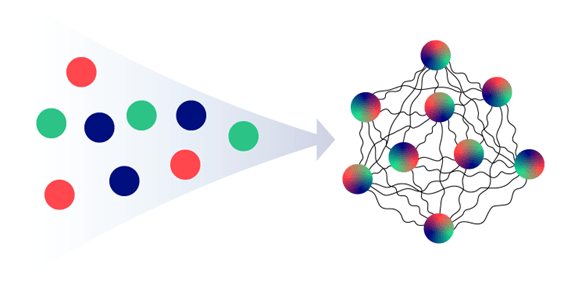Researchers have discovered in a study published in Physical Review D that neutrinos in a particularly dense environment can form significant correlations (or quantum entanglement) through mutual interactions.
 Neutrinos of different “flavor” quantum states (shown by colors) are entangled through interactions. In dense neutrino environments like core-collapse supernovae, this leads neutrinos of different flavors to equilibrate to similar energy distributions. Image Credit: Felix Sanchez
Neutrinos of different “flavor” quantum states (shown by colors) are entangled through interactions. In dense neutrino environments like core-collapse supernovae, this leads neutrinos of different flavors to equilibrate to similar energy distributions. Image Credit: Felix Sanchez
Neutrinos are considered “ghost particles” in the Standard Model of Particle Physics because they have weak interactions with ordinary matter. Neutrinos have the unique ability to change their identities or “flavors” as they interact.
Neutron star mergers and core-collapse supernovae can both exhibit this. Neutrinos with varying initial flavors eventually settle toward an equilibrium flavor and energy distribution that are similar.
The Impact
A core-collapse supernova, such as the one observed by scientists in the Large Magellanic Cloud in 1987, is a massive star’s death cry. These supernovae are cosmic factories that produce elements like sodium and aluminum. Neutrinos are believed to transport 99% of the energy emitted by a supernova.
The electron-flavor neutrino and its antiparticle are critical in transmitting energy and element synthesis in a supernova. Knowing the energy of these neutrinos’ flavor states allows scientists to better understand how a core-collapse supernova erupts and what components are produced.
Summary
For a few decades, scientists have known that the flavor development of neutrinos within a core-collapse supernova is a complex quantum mechanical phenomenon. Most of the available research on this process is based on the lowest-order approximation of the quantum version of the neutrino transport equation. However, this technique ignores the many-body entanglement of neutrinos’ flavor quantum states.
Recently, researchers investigated the quantum correlations that occur from keeping the entanglement that was ignored in previous studies of this problem. They discovered that by utilizing random matrix theory results, they can accurately mimic neutrinos’ interactions.
This conclusion also suggests that the neutrinos' quantum states will change chaotically when they interact with one another. Comprehensive numerical simulations later supported this finding and showed the genesis of this chaotic behavior.
The numerical results also reveal that, after interacting for a long enough period, each individual neutrino produces a mixed momentum-flavor state. The new findings can be used with numerical simulations of core-collapse supernovae. This might give new insights into the explosion process and nucleosynthesis in these massive cosmic events.
Department of Energy (DOE) Office of Science, Nuclear Physics program and Quantum Science Center, a DOE National Quantum Information Science Research Center supported the study.
Journal Reference:
Martin, J. D., et. al. (2024) Equilibration of quantum many-body fast neutrino flavor oscillations. Physical Review D. doi:10.1103/physrevd.108.123010